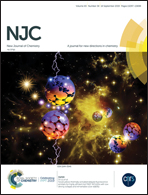Cytidine and ribothymidine nucleolipids synthesis, organogelation, and selective anion and metal ion responsiveness†
Abstract
Extending the functional utility of nucleolipids to natural nucleosides such as cytidine and ribothymidine would facilitate the development of supramolecular gels and responsive smart materials. We have reported long-acyl chain conjugated novel cytidine and ribothymidine nucleolipids. It is known that small chemical variations result in significant differences in the self-assembling processes of nucleolipids. When the fatty acid acyl chain is attached onto the cytidine (diacylated) or ribothymidine (triacylated) it does not support organogelation. But diacylated ribothymidines produce stable organogels in various organic solvents, ranging from polar to non-polar solvents. Further, single-crystal and 1H NMR analysis indicated that multiple H-bonding, CH–π, hydrophobic effects and solvent-mediated interactions are the main driving forces for the organogelation. These supramolecular gels show a selective responsive behavior with respective fluoride and mercury ions by gel to sol phase transitions. Unusual mercury mediated base pairing through sugar residues (sugar–Hg2+–sugar) and also mercury specificity for nucleolipid 7d in the presence of mixture of toxic metal ions have been thoroughly investigated.



 Please wait while we load your content...
Please wait while we load your content...